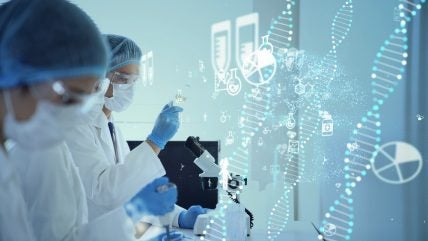
Regenerative Medicine is a multidisciplinary field of therapies, focusing on the repair, augmentation, replacement, or regeneration of damaged cells, tissues, genes or organs.
The Alliance for Regenerative Medicine classifies these therapies into four groups: 1) gene-based therapies, which seek to modify or introduce genes into the patient’s body; 2) genome editing, which involves modifications to the human genome; 3) cell therapy, where cells are administered into the human body to grow, repair or replace damaged tissue; and 4) tissue-engineered products and biomaterials, which aim to restore damaged tissue and organs through scaffolds, cells and biologically active molecules.
The rise of Regenerative Medicines such as cell and gene therapies could transform the future of medicine as we know it, enabling doctors to address the root cause of diseases rather than treating the symptoms. GlobalData valued the market for cell and gene therapies at $6 billion in 2023 and expects it to grow at a compound annual growth rate of 51.6% over the next seven years, reaching a value of $80 billion by 2029.
Ancillary materials in cell and gene therapy production
Many of the therapies under the Regenerative Medicine umbrella rely on cell culture media techniques such as mesenchymal stem cells (MSCs), induced pluripotent stem cells (iPSCs), and HEK-293 cells. The United States Pharmacopeia (USP) <1043> classifies the materials used for cell culture media in Regenerative Medicine as ancillary materials (AMs) and states that, while AMs are not intended to be present in the final product, “the quality of an AM can affect the stability, safety, potency and purity of a cell, gene, or tissue-engineered product”.
The USP <1043> states that manufacturers of cell and gene therapies should therefore aim to source well-characterised ancillary materials wherever possible. Chosen materials should be approved or licensed products with established toxicological profiles and must be manufactured according to “controlled and documented procedures”.
The guidance also emphasises the importance of qualification programs for ancillary materials and includes a four-tier ranking system to help manufacturers classify risk. Under this system, risk levels are lowest in Tier 1 and highest in Tier 4. Animal-derived materials typically belong in the higher risk tiers (Tiers 3-4) due to the potential for variability and contamination. On the other hand, Tiers 1-2 include highly qualified or well-characterised materials and are considered low-risk AMs. For example, Tier 1 materials include approved or licensed drugs and biologics used ‘off label’ in the manufacturing of cell and gene therapies, while Tier 2 materials are specifically intended as AMs in drug and biologic manufacture.
Is Recombinant Insulin safe and suitable for Regenerative Medicine?
In Regenerative Medicine manufacturing, the need for ancillary materials of proven high quality and with a fully traceable manufacturing process has pushed biopharmaceutical companies to source premium-quality raw materials from well-respected cGMP suppliers such as Novo Nordisk Pharmatech. The company’s Recombinant Insulin product – also called Insulin Human AF – is used by many of the world’s leading pharmaceutical and biopharmaceutical companies to improve cell culture processes.
The addition of Recombinant Insulin to serum-free cell culture media formulations has a significant impact on cell proliferation and production. When supplemented to chemically defined media for expansion of iPSCs, Recombinant Insulin increases cell proliferation and improves cell morphology while maintaining high pluripotency markers expression. Recombinant Insulin is also used to increase viral vector production. In fact, in addition to improvement in cell proliferation, Recombinant Insulin boosts the yield of viral vectors expressed in HEK-293 cells by almost 50%.
Unlike Fetal Bovine Serum (FBS) or other cell culture media supplements derived from animals, Recombinant Insulin is a fully recombinant, animal-free protein produced in yeast. Novo Nordisk Pharmatech’s Recombinant Insulin is a Tier 2 low-risk material according to the classification system set out in the USP. This means it is a well-characterised product, produced under relevant cGMPs, with an intended use for biomanufacturing of therapeutic drugs, including cell therapies and cell-based-gene therapies.
It comes with full traceability and documentation to satisfy customers’ qualification needs and has a high level of batch-to-batch consistency to ensure premium quality time after time. Integrating high-quality raw materials like Novo Nordisk Pharmatech’s Recombinant Insulin in the early development stage of cell and gene therapies can streamline the development process and accelerate the regulatory approval of new cell and gene therapies.
To learn more, please download the whitepaper below.


